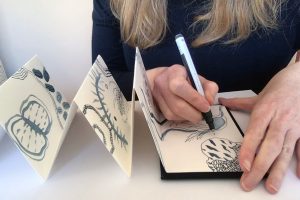We recently caught up with Melbourne based multidisciplinary artist and textile designer, Jess Hall… here’s what she shared with us…
Please tell us a little about yourself, your processes and practice…
I am a Melbourne based multidisciplinary artist working with drawing, painting and embroidery. I am also a textile designer and have recently launched my own collection of silk scarves which are based on my paintings.
Initially I went to art school in Brisbane at Queensland College of Art, majoring in painting with a lot of printmaking too. Back then I was an oil painter and remained so until I became pregnant with my first child. That’s when I connected more to my drawing practice and painting with watercolour and inks. I enrolled in the Bachelor of Textiles (Design) at RMIT and slowly worked my way through the course whilst being a full-time parent to my two children. The textile design was like the ‘missing link’ in my art practice which enabled me to reimagine my work in a new way, really bringing out the elements of pattern, tactility and materiality in my work. Learning textile design skills has enabled me to create work that sits between fine art and craft.
Somewhere in there I also did an MFA at Victorian College of the Arts and had a studio at the Abbotsford Convent for a couple of years.

Please tell us a little about your works, how they evolve, what inspires you to create them
I make works on paper and small and large-scale painting/embroideries that utilise my skills as a painter and a textile designer.
The works are about tradition and innovation, using traditional craft practices in a contemporary context, and the liminal spaces between art and craft and art and science. I use a wide range of imagery; botanical, cellular, anatomical and create imaginative, fantastical works from the combination of this imagery.
Studying textile design really helped me to organise and find strong working methods for my art practice. I now make plenty of trials that I keep in a technical file along with preparatory drawings, where ideas are explored first before the final piece is begun. However, I still work quite organically in terms of composition; allowing the negative space and the relationship between shapes to form the work.
Can you please share with us what sort of studio or workspace you currently create in?
I work from home as it suits being a single parent to my two school age children. I have a lovely, light filled back room where I spend a lot of my time creating.
What are some of the processes and techniques you use?
My textile works make use of a range of embroidery stitches like backstitch, French knots, split stitch, brick stitch, turkey rug stitch, rope stitch and crochet. Dye is hand painted on to linen and embroidery is used as a drawing technique. Small embroideries are framed and presented as individual specimens.
The works on paper are where my descriptive, imaginative drawing techniques and ideas come into play. I use imagined life forms that are created from the influence of Australian and European flora and cellular, anatomical imagery. Pattern and repetition are used to form an overall aesthetic and feeling to the work and colour relationships are often tonal. I reference textiles, pattern, printmaking, and fashion in my work.
Please tell us what or who inspires and drives your creative practice.
The intersection between art and science, art and craft, craft and feminism are constant sources of inspiration for my work. My art has developed alongside major developments in my life and when I look at my art heroes like Louise Bourgeois, Sonia Delaunay, Mirka Mora, Kusama, I’m always fascinated by how the art/life interaction works, particularly for female artists.
Is there a special piece of advice which you cherish and work by?
When I was at art school the lecturers told us that doing well as an artist was 90% hard work and 10% luck and I have often reflected on that. The importance of self-belief and just continuing to create and adapt are fundamental aspects of my approach to being an artist.
